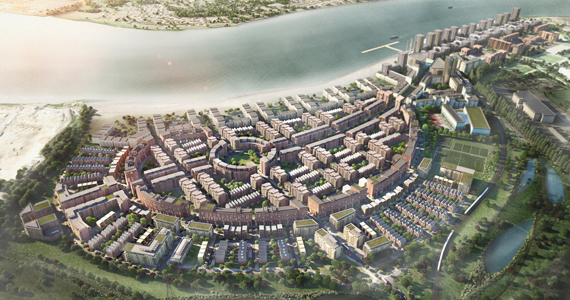The merger of L&Q and East Thames Group is creating a monster, but who is it going after? Alexander Peace meets its chief executive to find out more. Portrait by Jon Enoch

In a plain office in Stratford, east London, away from the sparkling towers and bustling shopping centres, a monster has been in the making.
At £20bn, it is big enough to swallow Land Securities whole and a housebuilder for dessert. Bursting with 90,000 homes on its books, it is larger than the entire institutional private rented sector.
It is a monster with awesome intent: to build 100,000 homes in the next decade with the £700m it raises each year from the bond markets. This means it is going to compete directly with the private sector for land, people and resources.
But here is why the industry needs to sit up and take notice. The mild-mannered face of this beast doesn’t want to compete with housebuilders. David Montague, chief executive of L&Q, which merged this week with the East Thames Group, wants to be their friend.
In the post-referendum market, L&Q wants to help housebuilders and developers worried about pre-sales and funding to de-risk their schemes, by taking blocks from them.
“It’s those early sales you are going to be worried about,” he says. “But if you team up with L&Q, we can guarantee those sales.”
Rapid growth
Despite its vast size, of all the housing association mergers on the cards – Sovereign and Spectrum, Places for People and Derwent HA – L&Q’s is not the largest.
But it is arguably the most ambitious. Montague says the company is going to have the capacity to build 25,000 private sale homes and 25,000 private rental homes over the next 10 years, alongside 50,000 affordable units, mostly in London and the South East.
Such a grand plan might seem pie in the sky, but Montague knows his numbers; he’s an accountant by training. The 90,000 homes L&Q has on its books means it can borrow very cheaply off its balance sheets.
“Housebuilders do not have those 90,000 homes in London and the South East, so we just have this enormous advantage,” he says.
Nor does L&Q have shareholders to pay off, with all profits going back into development.
“When we complete this deal, we will be up there with Barratt, Taylor Wimpey and the other big ones. We can compete in the same marketplace that housebuilders do,” he says.
But co-operation works out better for everyone. No one wants a repeat of housing associations overreaching themselves, as they did pre-financial crisis, and needing a bailout.
Co-operation also goes a long way towards solving the housing crisis.
“We have a government that wants to see more homes built. Our reputations are on the line. It is in our joint interests to do more together,” Montague says.
It seems he wants to cosy up to everyone.
In London, he is talking to TfL, the capital’s single largest landholder, and he is on the mayor’s Homes for Londoners board.
Outside the capital, L&Q has started a test case with Trafford Housing Association for a Manchester expansion, as there were just not enough opportunities in the South East. The test is a modest 2,000 homes in scale.
“We will talk to anybody that wants to talk to us. We are keen to build as many homes as we can,” says Montague.
“So yes, we are talking to TfL, we will talk to anyone.”
The nouveau riche
And how, exactly, is L&Q proposing to pay for all of this? Firstly, it is changing the way it borrows money.
Housing associations were first permitted to borrow from the private sector in 1988. Due to reticence at the time, amounts, gearing and interest covenants were all restricted.
With the launch of the new company, L&Q has taken the opportunity to renegotiate those terms and to borrow more. And at a higher gearing.
“To reset the balance sheet of an organisation is not cheap, and you can only do it if you are creating something substantial,” says Montague.
“But I believe what we are doing will show that if you create something of scale, then you can do things differently.
“You can unleash your balance sheet and do a great deal more.”
Alongside that, L&Q will continue with its customary bond raising, one of the key reasons it is able to undercut housebuilders. Its last raise amounted to £300m. Montague says each year for the next 10 years, L&Q will raise between £600m and £700m.
This, he hopes, is going to attract new investors into the model.
“If we are going to treble our output, we need to broaden our investor base.
“So we are developing relationships with new investors, trading bonds in our own name and doing quarterly statements in the same way as a quoted company.
“We have historic capital grants sitting on our balance sheets, which take the first hit in the event of a disaster, and it is invested in property in London and the South East.
“You just do not get better than that.”
The risks
Ask most private developers what they think about housing association expansion and they will say great in principle, poor in execution: overpaying for sites, poor management, and future interest rate hikes are all issues. Montague, a credit to his accounting past, is far from laissez-faire.
“While there have been a number of rescues in our history, no investor has ever lost a penny as a result of a housing association failure,” he says. He attributes this to strong independent regulation, and the ability of other housing associations to step in to rescue others.
In L&Q’s case, it acquired four other housing associations in five years in the 1990s.
L&Q also has what Montague describes as a “pretty sophisticated” approach to risk management.
“We have put it through rating agencies, the regulator and our board, and we are confident that in the event of a market downturn, we will be fine.”
To give some idea of that testing, L&Q assumes a disaster scenario, then works out how much it will still be able to borrow while maintaining an A rating on the bond markets.
The disaster is a 25% reduction in house prices sustained for five years, with falling rents, and rising costs and interest rates.
Basically, everything moves in the wrong direction, with no perceivable recovery: a more stressful situation than many housebuilders envisage.

Still a housing association
But beyond all the numbers, the dreams of world domination and the ambition to single-handedly solve the housing crisis, L&Q remains a housing association – with a social mission.
In that vein, how does Montague stack up maximising the sale of private units to fund the affordable?
Open a copy of the Evening Standard and you will see one-beds on new schemes going for more than £400,000.
Rents on L&Q’s Lewisham PRS scheme are considerably above the local average.
“We went into the recession in 2008 with a pipeline of 5,000. Today it is 50,000 and on 1 December, it will be 100,000, of which half is affordable,” he says.
Basically, the more they can do, the better.
Furthermore, L&Q is creating mixed communities.
“Quite often, you get housing associations pondering whether they would still do outright sale if the government provided 100% funding,” says Montague.
“In our case we would, because people want to buy, because we believe in mixed communities, because it would enable the government money to be stretched further, and also because it gives you greater independence.”
Man or monster?
For a man heading a beast of a housebuilder, Montague speaks with modesty and sincerity.
The only time his brow ruffles is when asked about those who don’t like the housing association moniker.
“It bothers me when people disassociate themselves from the sector,” he says.
“There are some brilliant associations that are leading change.
“I am really proud to work for a housing association, which enables us to change the places where we live.
There is no better job than that.”
Behind the mind boggling numbers, the thousands of homes and the enormous potential maybe not such a monster after all.
A BRIEF HISTORY OF HOUSING ASSOCIATION MERGERS
After the 2015 elections, housing associations were hit with the double whammy of being eligible for Right to Buy and having to reduce their rents by 1% each year for the next four years.
However, there were relaxations about what they could build to fund this. Many started to go essentially 50:50 private:social development.
Larger companies offer more stability to do this, hence the flurry of mergers. However, merging two boards and non-executive boards, when people do not want to step down, is difficult.
L&Q, East Thames and Hyde Group housing associations announced their intention to merge in April. Hyde then dropped out in August.
WHY HOUSING ASSOCIATIONS MATTER
- Because as the EU departure bites and the housing market slows, they are going to keep building
- Because whatever government stimulus package there will be, the private sector will not build more than 160,000 homes a year, and other players need to pick up that slack
- Because of their enormous balance sheets, which are highly rated, can borrow more cheaply than housebuilders
- Because their mixed-tenure approach means they can bring forward big schemes far faster than a normal housebuilder
- Because they want to work with housebuilders, not against them, and help de-risk schemes in a time of uncertainty
HOW THE MERGER ADDS UP
East Thames |
L&Q |
Combined post-merger |
|
|---|---|---|---|
| Total units under management | 14,996 | 79,646 | 94,642 |
| Net worth | £4.1bn | £17.5bn | £20bn (estimated) |
| Pipeline units | 1,674 | 41,700 | 43,374 immediately, 100,000 over 10 years |
| Debt | £45m | £2.2bn total loans | – |
| Last capital rise | £50m loan, December 2014 | £300m bond issue, May 2016 | – |
| Board and exec teams | Yvonne Arrowsmith Chief executive Olu Olanrewaju Simon Bass Trevor Burns |
David Montague Chief executive Waqar Ahmed Mike Donaldson Jerome Geoghegan Diane Hart Tom Nicholls Tim Mulvenna |
David Montague Chief executive Yvonne Arrowsmith Waqar Ahmed Mike Donaldson Jerome Geoghegan Diane Hart Tom Nicholls Tim Mulvenna Olu Olanrewaju |
• To send feedback, e-mail alex.peace@estatesgazette.com or tweet @egalexpeace or @estatesgazette
The bottom line: Beyond all the numbers, the dreams of world domination and the ambition to single-handedly solve the housing crisis, L&Q remains a housing association – with a social mission.
RELATED ARTICLES
Housing associations: Love is in the air
Whitechapel resi scheme approved
L&Q has secured planning for a 564-home mixed-use scheme in Whitechapel, E1 …read more
Khan approves Barking Riverside plans
L&Q pushes into the North West
ALSO THIS WEEK
One Blackfriars: the South Bank’s latest luxury residential tower makes its mark
But developer St George remains bullish.













